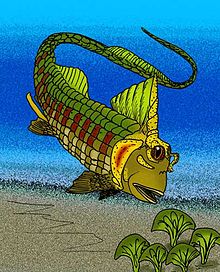This article has multiple issues. Please help improve it or discuss these issues on the talk page. (Learn how and when to remove these messages)
|
| Campbellodus Temporal range: Late Frasnian
| |
|---|---|

| |
| Artist's reconstruction | |
| Scientific classification | |
| Domain: | Eukaryota |
| Kingdom: | Animalia |
| Phylum: | Chordata |
| Class: | †Placodermi |
| Order: | †Ptyctodontida |
| Family: | †Ptyctodontidae |
| Genus: | †Campbellodus Miles & Young, 1977 |
| Species: | †C. decipiens
|
| Binomial name | |
| †Campbellodus decipiens Miles & Young, 1977
| |
| Synonyms | |
| |
Campbellodus decipiens is an extinct ptyctodontid placoderm fish that lived around 380 million years ago (Late Devonian). Its fossil remains have been found preserved in perfect three-dimensional form from the Gogo Formation of Western Australia. Originally it was described from large tooth plates and isolated skull roof bones by Miles & Young (1977). Long (1995) restored the complete fish based on new material found at Gogo in the mid 1980s, and described by Long (1997).
Campbellodus has very short spinal plates, and is unusual in having a high dorsal spine formed by three median dorsal plates. The tooth plates are very robust and the upper plate has a high anterior spine.